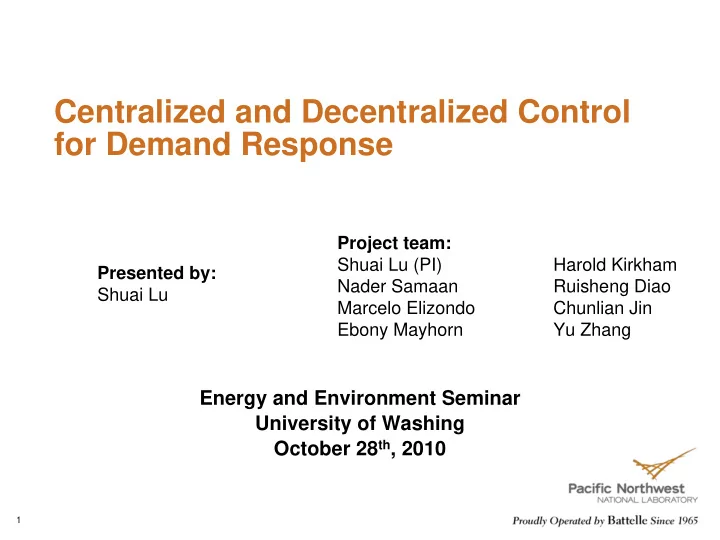

Centralized and Decentralized Control for Demand Response Project team: Shuai Lu (PI) Harold Kirkham Presented by: Nader Samaan Ruisheng Diao Shuai Lu Marcelo Elizondo Chunlian Jin Ebony Mayhorn Yu Zhang Energy and Environment Seminar University of Washing October 28 th , 2010 1
Outline Concept of demand response Types of demand response programs Centralized and decentralized control in existing power systems Models to simulate the effects of demand response Comparing the two control philosophies Concluding remarks
Defining Demand Response An earlier definition by FERC (2008)[1]: A reduction in the consumption of electric energy by customers from their expected consumption in response to an increase in the price of electric energy or to incentive payments designed to induce lower consumption of electric energy. Newer definition by FERC (2010)[2]: “demand response” includes consumer actions that can change any part of the load profile of a utility or region. smart appliances or devices that can respond automatically to the signals from utility or changes of power system condition. smart integration of changeable consumption with variable generation (wind and solar) manage demand as needed to provide grid services such as regulation and reserves [1] Wholesale Competition in Regions with Organized Electric Markets , FERC Order No. 719, October 2008 [2] National Action Plan on Demand Response . FERC, June 2010
Type of Demand Response Programs FERC DR Categorization [3]: Type 1: dynamic pricing without enabling technologies (manual response to price signal) Type 2: dynamic pricing with enabling technologies (automatic response to price signal) Type 3: direct load control Type 4: interruptible tariffs Type 5: demand response programs operated by Independent System Operators (ISO) or utilities (providing various reserves for the system) Another category that need to be added: Type 6: autonomous load response to frequency and voltage [3] A National Assessment of Demand Response Potential , FERC, June 2009 4
Group DR Programs Based on Control Approaches Location where the Grouping Criteria information is from Local Center Location Local Type 6 *Types 1 & 2 where the response Central Types 3, 4 & decision is 5 made *If the price is generated through an auction process, in which both generation and demand submit bids in real time to get a market clearing price, then DR Type 1 and 2 could be considered decentralized control. Otherwise, if the price signal is “designed” by the system operator according to certain physical variables of the system, Type 1 and 2 could be considered a combination of centralized and decentralized control, 5
Centralized and Decentralized Control in Existing Power Systems Purpose of controls To maintain system voltages and frequency and other system variables within their acceptable limits, in response to normal load and generation variations as well as large disturbances. Centralized controls Generation scheduling and dispatch Automatic generation control for frequency regulation Real and reactive power flow adjustments to resolve congestions or reduce loss Decentralized controls Generator governor response Automatic voltage regulation Protection relays 6
A Test Platform for Demand Response Control Approaches 848 846 822 820 844 864 818 842 802 806 808 814 850 824 826 860 836 812 834 858 840 816 832 862 800 888 890 810 838 852 828 830 854 856 Modified IEEE 34 bus test feeder: Lumped loads were replaced by 147 detailed household load models; A load factor of 40% was assumed to determine the number of households. 7
Water Heater Model Electric power Water temperature DIgSILENT 45.00006 Water flow 45.00004 45.00002 45.00000 44.99998 44.99996 44.99994 -0.0000 4.8000 9.6000 14.400 19.200 [h] 24.000 test_blick: y1 130.00 120.00 110.00 100.00 Water temperature 90.00 80.00 70.00 -0.0000 4.8000 9.6000 14.400 19.200 [h] 24.000 test_blick: Tw 0.005 0.004 0.003 0.002 0.001 0.000 -0.001 -0.0000 4.8000 9.6000 14.400 19.200 [h] 24.000 water heater_single: Total Active Power in MW Active power myinputs(2) Date: 7/9/2010 8 8 Annex: /2
Air Conditioning Model Equivalent Thermal Parameters Circuit 0.0000 2000.0 4000.0 6000.0 8000.0 [s] 10000.0 PQ Measurement: Active Power in p.u. 84.00 83.00 82.00 81.00 80.00 Outdoor temperature -0.0000 2000.0 4000.0 6000.0 8000.0 [s] 10000.0 House Common Model: To 3.00 2.00 1.00 0.00 -1.00 Active power -0.0000 2000.0 4000.0 6000.0 8000.0 [s] 10000.0 House Common Model: p 79.00 78.00 77.00 76.00 75.00 74.00 73.00 0 0000 2000 0 4000 0 6000 0 8000 0 [s] 10000 0 Indoor temperature 9 9
Ten Types of House Load Representing Other Appliances Information of the 10 types house Residence Occupants_ site Size number 28 2965 4 60 3156 3 100 2510 3 110 1518 2 250 1248 2 344 4119 6 361 2416 4 364 868 1 483 1988 2 500 2676 3 Other appliances data is taken from ELCAP load data set 10 10
Single House Model A/C Other Water Heater appliances 11 11
Response Mechanisms in the Household Load Model All demand responses come from A/C units and water heaters, i.e., thermostat-controlled loads. Centralized control Proportional controllers for temperature settings adjustment Direct on/off control Communication delays are added Decentralized control Bang-bang controllers for frequency, voltage and price responses 12
Simulations of the Two Control Approaches Two types of DR functions were simulated: Response to power system frequency dip Balancing generation and load (regulation and load following services) The modified IEEE 34 bus feeder is connected to the IEEE 39 bus transmission system model to simulate frequency response. Regulation signal from a balancing authority and wind power derived from actual wind data were used to test balancing services. 13
Recommend
More recommend